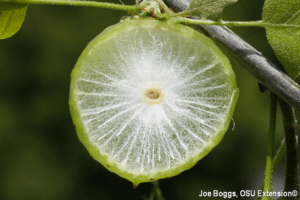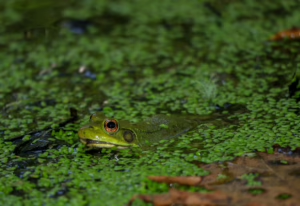Noticing Nature with Doc Fred, April 2024
“Doc Fred, Doc Fred! We found this green ‘ball-thing’ over at Outdoor Living Skills. What is it?” I smiled to myself at the exuberance of my young naturalists and suggested that rather than telling them what it is, how about making it today’s Natural History Mystery, which they could have the honor of presenting to the whole camp? And so it was.
As we all learned the next day, when their mystery was unveiled, the boys had found a common kind of plant gall, specifically an Oak Apple Gall (note: the word “gall” comes to us from Latin galla referring to such oak “apples”) .
Plant galls are among the most peculiar and mysterious of Nature’s curiosities. One reason is that they seem so out of place. For instance, a spherical oak apple appears where there should be an ordinary oak leaf. Another kind replaces a willow branch tip with what looks like a pine cone. Or, a grotesque red tuber appears in place of an ordinary rose bush root. The variety of gall morphotypes is enormous, with most flowering (and other) plants (even some algae) hosting one or more kinds.
A gall forms when some foreign biological agent hijacks the morphogenetic program governing the normal development of competent host-plant tissues, forcing them on a different growth trajectory. The new structure produced (i.e., the gall) always represents an adaptation for the agent, and in certain cases may actually benefit its host, as well.
 The sheer diversity of gall producing agents boggles the mind. The vast majority are insects (6 different orders, but mainly tiny flies and wasps, the former numbering over 200K species alone!) with minor roles played by a group of bizarre mites, nematode worms, certain weird rotifers and crustaceans , fungi, bacteria, viruses, and even other plants.
The sheer diversity of gall producing agents boggles the mind. The vast majority are insects (6 different orders, but mainly tiny flies and wasps, the former numbering over 200K species alone!) with minor roles played by a group of bizarre mites, nematode worms, certain weird rotifers and crustaceans , fungi, bacteria, viruses, and even other plants.
“Galling” is a sophisticated kind of symbiosis: not parasitism , nor disease, nor malignancy, but something uniquely other. The phenomenon can be traced back in the fossil record to the Devonian Period, although modern gall morphology comes much later in the Carboniferous , and especially in the Cretaceous and beyond with the advent of flowering plants and their association with insects.
Once initiated, the ongoing development of every gall must be maintained continuously by the gall agent or its offspring, which are protected from desiccation, predators and parasitoids by the surrounding structure, and usually feed on nutritious tissues they induce within it. Consider the so-called “empty” Oak Apple Gall that our intrepid campers found. It was initiated by a nearly microscopic female cynipid wasp that, prior to leaf-out in spring, injected an egg along with a cocktail of sophisticated effector molecules (including plant immunity suppressors, various plant growth and development hormones and/or their mimics ) into a Red Oak leaf primordium. Once hatched, the developing wasp grub took over the ongoing task of gall development by producing its own effectors. After metamorphosis, the adult wasp would bore out of the gall, mate and begin a new phase in the wasp’s life history. Afterward, the now depleted gall structure would continue to function ecologically by sheltering other insects and small animals for some time to come.
Perhaps not coincidentally, many kinds of insect (and mite) galls bear a striking resemblance to fruits (and perhaps flowers). For example, some are succulent (even to exuding a sugary nectar much relished by bees, wasps and ants); some release an alluring scent and/or are appealingly colored, etc. More telling, the formation of certain galls is known to involve the activation of plant fruiting and flowering genes.
Consider the case of figs (genus Ficus) which bear highly specialized, globular, enclosed inflorescences (which eventually become the “figs”), each filled with tiny flowers. A fig inflorescence typically contains female flowers of two basic types–one ordinarily “galled” but not pollinated by minute female Fig Gall Wasps ; the other, ordinarily pollinated but not galled by those same wasps. After emerging from their flower galls and mating, female wasps gather pollen from male flowers (perhaps contained in separate inflorescences) and then proceed to cross pollinate and gall other fig flowers. This elaborate and intricate, obligate mutualism (i.e., only fig wasps can gall fig flowers which go on to produce more wasps, and only these can both pollinate and gall other fig flowers producing future generations of figs and wasps …), is a most amazing example of a link between insect gall induction and the formation of fruit. Whatever direct control flower-galling has over subsequent fig ripening, however, remains to be seen.
All this leads to the intriguing but controversial theory that fruiting (and perhaps even flowering) actually derives evolutionarily from ancient insect gall formation. The idea is that originally most of the genetic basis for galling resided in the gall inducer (and/or its bacterial symbionts), not the plant. Over time many of the genes involved were laterally transferred (again by bacteria or viruses) to the flowering plant genome, where they now function autonomously to produce fruits (and flowers?) and are only secondarily recruited during gall induction and development.
We’ll conclude with some interesting ethnobotanical aspects of galls. Nutritious tree galls might be a good food source were it not for their high tannin content. Yet, undeterred, Ozark farmers once fed oak galls (along with acorns) to their hogs, imparting a unique flavor to hams. Despite this drawback, oak gall tannins (gallotannins) do have some particularly useful properties. Through a chemical reaction with Iron Sulfate gallotannins almost magically yield a remarkably indelible blue-black ink that at one time was prescribed by law for official documents (think, the US Declaration of Independence and Constitution). Being especially rich in gallotannins , Aleppo Oak Galls of the Near and Middle East were once a valuable export commodity for this reason. Similarly, galls are used in making certain traditional dyestuffs. Finally, for centuries galls have figured in folk medicine. Today, gall phytochemicals are being actively investigated for their potential pharmaceutical properties.
Remember– when on your adventures in Nature keep an eye out for galls. They are sure to peek your curiosity and are begging to tell you their marvelous stories.
– Doc Fred Cichocki






